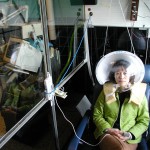The following excerpts are from the E-mail discussion of the committee on chronic mountain sickness, prior to The 3rd World Congress on Mountain Medicine and High Altitude Physiology and The 18th Japanese Symposium on Mountain Medicine carried out in Matsumoto, Japan (May 20th – 24th, 1998). Part 1/2.
 Inside the Hyperoxic/hypoxic adaptation chamber using the Bogomoletz helmet.
Inside the Hyperoxic/hypoxic adaptation chamber using the Bogomoletz helmet.
From: “GUSTAVO ZUBIETA M.D. * IPPA *” Date: 20 Mar 98 16:16:43 Subject: Re: CMS Symposium X-mailer: Pegasus Mail v2.3 (R5). To: “John Reeves”
Dear Jack: Thank you for your E-mail of march 15. We were out of town and just returned yesterday.
You wrote: > I have the abstract “Incidence of Disease at High Altitude in La Paz > Bolivia”. Will that be the subject of your presentation in the CMS session?
Yes, we consider this to be more adequate to our field than in the high altitude population in the world symposium. In fact we meant to deal more with CMS in this presentation.
> How long are you planning to talk? Would 20 minutes be fine? Keep in mind that we are hoping for as much time as possible for discussion. One of the main question that will require discussion is that of the definition of CMS, so that we can all play from the same sheet music. In your case, do you include or exclude persons with chronic lung disease in the CMS group?
Following is the summary of the modest opinion of my father and myself, from many years of observations in the bowl-shaped city of La Paz to El Alto (between 3100m and 4100m), with much CMS in a population above 1.2 million:
1) In our concept, CMS or Monge’s disease are adequate denominations for a disease present only in hypoxic conditions due mainly to respiratory and ventilatory alterations of different etiopathogenesis, some complicated by other alterations such as kidney disease, arterial hypertension, and so on.
2) CMS at high altitude is expressed as cyanosis and low arterial saturation which gives rise to pulmonary hypertension and increased polycythemia, as compensatory mechanisms of adaptation to the disease under hypoxic conditions.
3) CMS is irreversible in diseases like pulmonary fibrosis, and reversible in chronic bronchitis, for example. If the arterial blood is completely saturated at 98%, as such is the case when the subject descends to sea level, there is a regression of the symptoms and signs. Giving continuous oxygen administration to a patient with COPD at sea level, will achieve similar results.
4) Respiratory diseases are the same at high altitude, in etiopathogenesis as those of sea level; but the impaired respiratory function, with low oxygen saturation, below the plateau of the saturation curve (in the steep part), shows us what we know as CMS or Monge’s disease.
5) Since CMS is a common denominator of diverse diseases of the respiratory system, each case should be diagnosed and treated according to the etiopathogenesis. It seems also evident that some subjects are more prone to suffer pulmonary diseases. Similarly, men have a greater tendency to develop pulmonary disease, than women and consequently are more susceptible to develop CMS. So, hoping to answer your question: The confusion arrives because the classical description of Monge’s disease in 1928, expressed that there is no pulmonary anatomical or functional alterations, not able to become evident at the time, due to the lack of modern technology that we have nowadays. Not all patients with respiratory disease at high altitude develop CMS. Some pulmonary diseases alter as a sequelae the pulmonary function, like impaired diffusion, uneven ventilation, increased shunt, or hypoventilation. These lead to low saturations in hypoxic conditions and to CMS. Please read our article New Concepts on Chronic Mountain Sickness.
We enjoyed preparing these comments, and if you should have any doubts, questions or comments please feel free to send us an E- mail. We were hoping to meet you in Cuzco, and inquired about you but they said you were in Russia. We were supposed to go the meeting in Ukraine invited by Beloshitsky. We ran into many problems. We couldn’t get to Ukraine from Moscow. We will tell you more when we meet in Japan.
Gustavo Sr. & Gustavo Jr. ~~~~~~~~~~~~~~~~~~~~~~~~~~~~~~~~~~~~~~~ Gustavo Zubieta, M.D. HIGH ALTITUDE PATHOLOGY INSTITUTE * IPPA * Av. Saavedra 2302 Tel: 591-2-368734 P.O. BOX 2852 Fax: 591-2-229504 La Paz, Bolivia E-mail: zubieta@oxygen.bo
